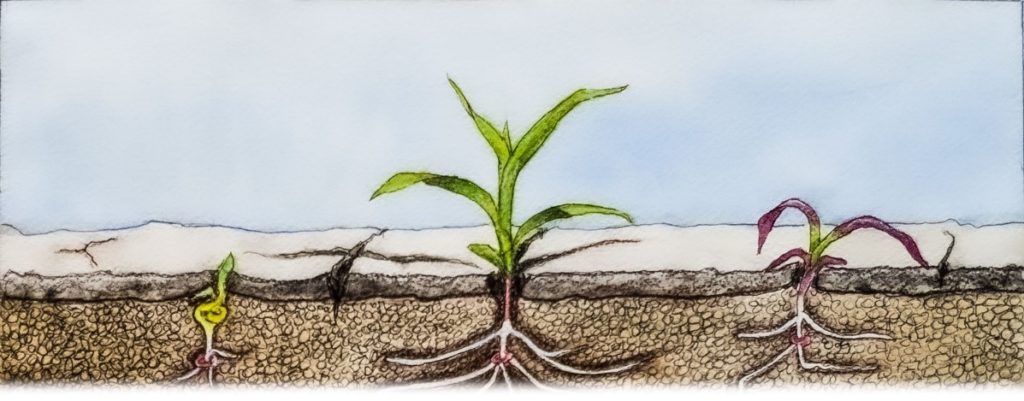FARM TIPS
Types of soil compaction
Illustrations by Marilyn Cummins
Compaction comes in many forms with many causes, some natural due to interactions of soil type and weather, but most caused by choices in timing, cropping methods, traffic patterns, equipment types and settings used in fieldwork. Unfortunately, compaction is not always easy to spot, literally hiding below the surface as a factor in nutrient deficiency, stress from drought or too much water, and other yield robbers.

Surface crusting can trap germinating plants and cause corkscrewed mesocotyls in corn (left). The other two plants made it through the crust, but the purple one shows signs of phosphorus deficiency due to root growth stunted by surface and shallow compaction.
Surface crusting
Moderate to intense rain after planting causes fine surface particles to bind together and fill in surface pores. Thick, impermeable crust forms as soil dries. Fast-drying soil and excessive secondary tillage increase risk of crusting.
Impact: Reduced seedling emergence and crop stand establishment; poor water infiltration; more runoff and erosion.
Prevention/remedy: Increase organic matter. Improve soil structure and increase surface crop residue with reduced tillage or no-till. Break up crusts with rotary hoe to improve emergence and stand.

Topsoil or shallow compaction. Tightly packed crumbs and large blocks of compacted soil in the tillage zone restrict root growth and deprive crops of the oxygen needed for nutrient and water uptake.
Topsoil or shallow compaction
Wheel traffic compresses soil particles from surface down through normal tillage zone, especially in moist conditions. Settling of tilled soil can also cause shallow compaction.
Impact: Varies, but can harm crop health and yield, especially in wet growing seasons. Compaction usually temporary and can be remediated.
Prevention/remedy: Stay off field in poor conditions and use lower tire pressures. Can partially remediate with normal tillage. Over time, natural processes of freeze-thaw and wet-dry cycles, microbial activity and plant root growth can rebuild structure.

Tillage/plow pan compaction. When corn roots encounter tillage and plow pan layers, they’re forced to grow where they can find weaknesses, and end up stubby with few root hairs.
Tillage or plow pan
Repeated tilling at the same depth (especially with discs, moldboard plows and sweep-type implements) and wheel traffic can result in a hard layer of subsoil compaction a few inches thick, directly below normal tillage zone (about 15-30 centimetres below surface).
Impact: Reduced yields in extreme weather years. In wet years: drainage problems, waterlogging and denitrification. In dry years: roots confined by compaction and have less access to deep available soil water.
Prevention/remedy: Complicated, but consider less-intensive tillage while adding organic matter; strip tilling; breaking up the pan with deep tillage/subsoiling (but only when entire tillage depth is dry and the depth of the tillage layer is known); reduce heavy traffic.

Deep subsoil compaction can cause long-lasting areas of dense, unhealthy soil that drains poorly, lacks oxygen and inhibits root growth, plant health and yields.
Deep subsoil compaction
High axle-weight loads from grain carts and combines can compact soil more than 60 centimetres down into soil profile, especially on wet soils.
Impact: Poor crop growth and yield for years after it occurs.
Prevention/remedy: Stay off wet fields. Evaluate all traffic practices. Use better weight distribution with larger tire footprints, more axles, tracks. Use controlled traffic lanes, fill carts only on headlands, and don’t fill carts or combine grain tanks to capacity, when possible. Hard to eliminate.

Sidewall compaction, especially as furrow walls dry and harden, can leave nodal roots with nowhere to go but up and down the seed slot. It also can cause furrows to reopen, letting light trigger the plant to start to leaf out before it reaches the soil surface.
Sidewall compaction
Planting in too-wet soils and/or with too much row-unit downforce is a main cause. Disc openers shear into wet soils, making furrow sidewalls hard. Can get worse with shallow planting depth and poor soil structure in tilled fields.
Impact: Poor crop emergence and stunted root development. Crop more susceptible to drought and nutrient stress. Severe sidewall compaction can cut corn yield 50%.
Prevention/remedy: Don’t plant into wet soil. Reduce (or automate) downforce on gauge and closing wheels. Try spiked closing wheel or wheels and seed firmer to reduce sidewall effects. For corn, plant seed 4 centimetres or deeper.
